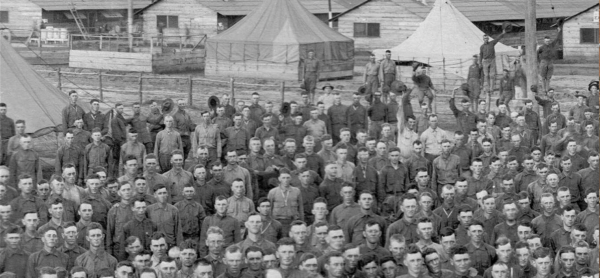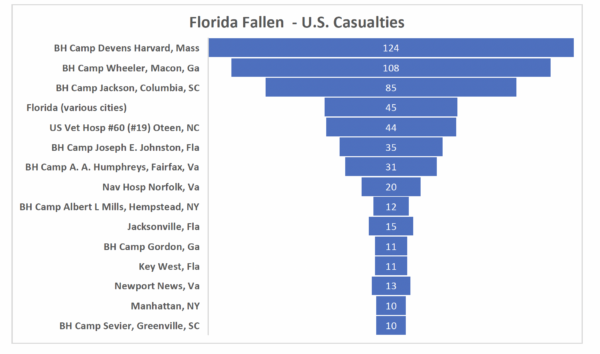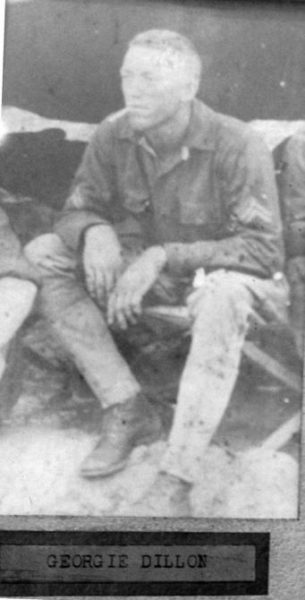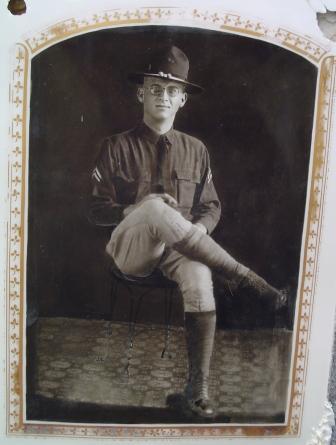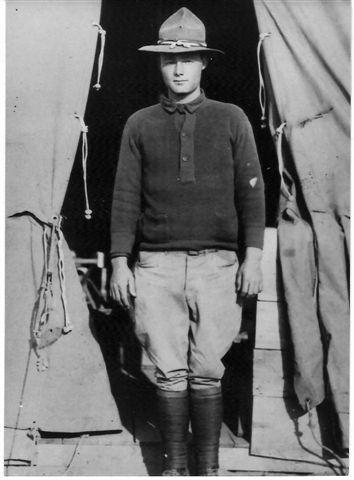124th Infantry (Florida National Guard), Camp Wheeler, Macon, Georgia, January 16, 1918
At many as 108 of Florida’s Fallen died at Camp Wheeler, some 165 miles from the Florida-Georgia state line. Camp Wheeler was established in 1917 as one of 16 Army National Guard Mobilization and Training Camps. It cost $4 million to build and was named for Joseph Wheeler, who served as a brigadier general for the U.S. Army and as a lieutenant general for the Confederacy. It was home to the 31st Infantry Division in World War I, known as the “Dixie” Division, as most who trained here were from Alabama, Georgia, and Florida. The 31st Division spent most of the war in camp and was sent as a replacement division in France in October 1918, which meant individual members were dispersed to existing units. As a whole division, the 31st never saw combat. By the time the camp closed in 1919, 80,000 troops had trained there.
Most of Florida’s Fallen who died at Camp Wheeler were members of the 124th Infantry. The 1st and 2d Regiments of Florida National Guard Infantry were drafted into Federal service on August 5, 1917, at Jacksonville and Wauchula, respectively. Consolidated, reorganized, and redesignated as the 124th Infantry on October 1, the unit was assigned to the 31st Division, with headquarters at Camp Wheeler.
Florida troops, Camp Wheeler, February 1918
Most of the deaths among 124th Infantry troops occurred during the Fall 1917-Winter 1918 months. The number one cause of death was pneumonia, followed by meningitis, empyema, measles, and tuberculosis. There was one case each of mumps, appendicitis, heart failure, intestinal obstruction, pleurisy, septicemia, and septic thrombosis. Another one was shot to death while attempting to escape by a camp guard. Of the 108 of Florida’s Fallen, 100 died of respiratory illness or an influenza-like communicable disease.
The fact that so many deaths occurred in so brief a time alarmed everyone. The fear that their sons were being neglected or ill-treated prompted a call to action. Gov. Sidney Catts, whose own son was stationed at Wheeler and heard firsthand about conditions at the camp, called on President Wilson, the Chief of Staff, and Secretary of War to investigate, threatening to recall all Florida troops unless the government did something. In response, a team of medical investigators, led by Major General William C. Gorgas, surgeon general of the army, inspected Camp Wheeler on November 23, 1917. Gorgas reported that the camp was, overall, in good condition and the troops were being “well cared for.” Similar inspections by delegations from Alabama and Georgia came to the same conclusion. But there were legitimate causes for concern. For one thing, the camp of roughly 25,000 at the time was overcrowded and many men did not have adequate winter uniforms. Gorgas recommended that physical distancing be implemented, allowing for at least 50-square-feet of space per man. This meant reducing the number in tents from 9 to 5. In addition, Gorgas stipulated that no new recruits be allowed to enter the camp until the situation had improved.
Gorgas was also concerned about an epidemic at the camp. At the time of his visit, there were more than 3,000 cases of measles in the hospital, and 300 cases of pneumonia which had developed from the measles, though the death rate was comparatively low. Moreover, the men were in overcrowded wards without adequate nursing staff. Newton D. Baker, Secretary of War, who also visited the camp in February 1918, insisted that a new hospital wing under construction would help to alleviate this problem. Meanwhile, to help relieve overcrowding, Camp Wheeler officials transferred more than 125 convalescents to hospital at Fort McPherson near Atlanta. In addition, numerous tuberculosis patients were discharged from the Army and sent home, and more nurses were assigned to the base hospital at Wheeler. Finally, wooden barracks replaced tents. Such measures helped, and the number of cases declined. It was not until late Spring 1918, when 13,460 men, or about 80 per cent of the entire camp strength, were vaccinated against pneumonia, that the threat of pneumonia at Camp Wheeler finally subsided.
Among Florida’s Fallen at Camp Wheeler
John Eldred Jenkins
Born November 15, 1888, in Madison County, Florida, Jenkins was the oldest of three sons of Jessie Jenkins (1865-1937) and Frances (Fannie) Buston (1868-1937). A farmer in Dowling Park, Florida, he was inducted in the army at Live Oak, Florida on September 18, 1917. He was married and had a 1 ½ year-old-son at the time of his death, which occurred on February 3, 1918, owing to pneumonia. He was buried in Beulah Baptist Cemetery, Dowling Park, Suwanee County, Florida. Also dying on the same date as Jenkins at Camp Wheeler was Elzie Burke, of Westville Florida, who had enlisted in the Florida National Guard at Chipley on April 12, 1917.
George (Georgie) L. Dillon
One of seven children of Charles Marion Dillon (1854-1899) and Ida Adams (1856-1908) of Key West, Dillon was born on December 30, 1890. He worked as a fisherman in Hillsborough County (1910). In the 1914 city directory for Key West, he resided at 515 Margaret Street, along with his brother Earl, an Army sergeant, Romeo, also a fisherman, and Cleveland, a policeman. Corporal Dillon died of pneumonia at Camp Wheeler on December 3, 1917.
Alva Hovey Morris
Morris was born on October 26, 1893, in Cooper, Chilton County, Alabama, one of ten children of Robert Milo Morris (1862-1930) and Nola Downs (1872-1920). The Morrises moved to Gadsden County, Florida by 1910, and in 1917 Alva worked as a Fuller’s Earth clay miner in Quincy. An Army cook, he died of pneumonia on November 22, 1917, and was buried in Cool Springs Cemetery, Faceville, Decatur County, Georgia.
George Washington Bates
Bates was born in Fruitville, Florida on October 7, 1897, the oldest of six children of Thomas Jefferson Bates (1867-1951) and Claudie Eunice Hampton (1878-1957). He lived in Oak Hill, Florida, in 1900, and in Bunker, DeSoto County, in 1910. Corporal Bates died of pneumonia on December 14, 1917.
Jacob Franklin Stonebraker, Jr
Born in Arcadia, Florida, on October 22, 1896, he was the oldest of six children. He worked in his father’s hardware store prior to enlisting in Company K, Florida National Guard soon after the declaration of war against Germany. Before reporting for duty at Camp Wheeler, he married Lenora Crawford on May 25, 1917. On April 17, 1918, Corporal Stonebraker died of cerebral spinal meningitis at Camp Wheeler. His father, Jacob Stonebraker, was reportedly at his bedside. He had only been back at the camp a few weeks, having been in Florida on recruiting duty. He was buried in Oak Ridge Cemetery, Arcadia. He was survived by his wife, father, mother, three sisters, and two brothers, one of whom was George Thomas Stonebraker, a sergeant in the same company.
James William Thomas Pumphrey
Born on January 13, 1895, in Marianna, Florida, he was the oldest of eleven children of Alfred Daniel Pumphrey (1863-1908) and Hannah Butler (1871-1941). A turpentine worker in Compass Lake, he married Flossie Mae Willis on January 9, 1916. Private Pumphrey died of empyema on April 21, 1918.
List of known Florida’s Fallen at Camp Wheeler
| Name | Death Date | Cause of Death |
| Edward Abraham | 12/28/17 | measles |
| Jenkins Adams | 12/10/17 | empyema |
| Thomas Franklin Allen | 2/12/18 | pneumonia |
| Captain Emory Atkinson | 11/19/17 | lobar pneumonia |
| Horace John Barclay | 12/7/17 | pneumonia |
| George Washington Bates | 12/14/17 | lobar pneumonia |
| Leroy Walton Beck | 11/25/17 | lobar pneumonia |
| John Walter Bell | 12/2/17 | lobar pneumonia |
| William Henry Bradford | 4/20/18 | meningitis |
| Richard H. Brannen | 2/18/18 | septicemia |
| Franklin Lafayette Brown | 11/26/17 | broncho pneumonia |
| William (Willie) Barnes Bullard | 12/29/17 | lobar pneumonia |
| William L. Bunnells | 1/1/18 | lobar pneumonia |
| Elzie Burke | 2/3/18 | lobar pneumonia |
| John Thomas Butler | 11/15/17 | broncho pneumonia |
| Clinton Clive Caldwell | 11/25/17 | broncho pneumonia |
| Frank A. Caraway | 10/15/17 | tuberculosis |
| Wilton V. Carrigan | 11/12/17 | pneumonia |
| Thomas Jefferson Carter | 11/15/17 | lobar pneumonia |
| John William Clayton | 1/29/18 | mumps |
| Ralph Eugene Cooper | 3/7/18 | pneumonia |
| William Curtis Cutts | 11/26/17 | lobar pneumonia |
| Hampton Daniels | 12/25/17 | meningitis |
| George (Georgie) L. Dillon | 12/3/17 | pneumonia |
| Cassie G. Elmore | 11/17/17 | pneumonia |
| Allie J. Elmore | 12/25/17 | pneumonia |
| Martin Redding Frost, Jr | 11/17/17 | lobar pneumonia |
| George Wilson Frost, Jr | 1/26/18 | spinal meningitis |
| Charles (Charlie) Alfonso Gomes | 3/14/1918 | meningitis |
| Charles Leslie Halley | 5/28/18 | gunshot – escaping guard |
| Silas Tafford Harrell | 11/29/17 | pneumonia |
| Ralph H. Hart | 12/1/17 | lobar pneumonia |
| Lewis Owen Harvey | 11/17/17 | pneumonia |
| John Pickens Henry | 4/20/18 | lobar pneumonia |
| Ezekiel Hiers | 11/18/17 | pneumonia |
| Culpepper (Cullie) Durand Hodges | 11/28/17 | measles |
| Henry May Hodges | 1/6/18 | meningitis |
| Oscar Napolean Howard | 11/15/17 | pneumonia |
| James Monroe Hudson | 12/31/17 | empyema |
| John Eldred Jenkins | 2/3/18 | pneumonia |
| Charlie Jones | 11/1/18 | lobar pneumonia |
| Jesse George Washington Kirkland, Jr | 9/29/18 | pneumonia |
| Percy Eugene Knight | 12/1/17 | pneumonia |
| Herbert Jackson Knight | 12/29/17 | lobar pneumonia |
| Frank Asbury Lacy, Jr | 12/6/17 | measles |
| Joseph Coy Lastinger | 12/2/17 | pneumonia |
| Carl W. Lawton | 11/22/17 | lobar pneumonia |
| John Wilby Lee | 11/1/17 | lobar pneumonia |
| Claud Mack Leitner | 11/24/17 | lobar pneumonia |
| James Edwin Leitner | 11/24/17 | lobar pneumonia |
| L. Oren Livingston | 11/22/17 | measles |
| William Malcolm Lumsden | 4/22/18 | lobar pneumonia |
| Robert Clarence Lyles | 1/20/18 | cerebral spinal meningitis |
| Arthur Madden | 11/14/17 | pneumonia |
| Bacile Marvin Mathews | 11/17/17 | lobar pneumonia |
| John Joseph (Joe) Mayo | 11/1/17 | pneumonia |
| John Wilson McCranie, Jr | 5/6/18 | lobar pneumonia |
| Rogers McCullers | 8/27/18 | lobar pneumonia |
| Ira McKinney | 11/26/17 | lobar pneumonia |
| Robert Mitchell McLaulin | 4/20/18 | pneumonia |
| Patrick W. McLoughlin | 12/19/17 | tuberculosis |
| Harry B. Miley | 11/22/17 | pneumonia |
| Irvin Minton | 1/15/18 | lobar pneumonia |
| Homer Everett Mitchell | 11/28/17 | broncho pneumonia |
| George Mitchell | 12/27/17 | meningitis |
| Alva Hovey Morris | 11/22/17 | lobar pneumonia |
| John Martin Morris | 3/19/19 | tuberculosis |
| Henry Neel | 11/12/17 | pneumonia |
| William Franklin Nettles | 12/9/17 | empyema |
| Clarence Clay Orchard | 3/23/18 | meningitis |
| Raymond Arthur Orton | 1/2/18 | empyema |
| Burke Maria Ruben Pacetti | 11/20/17 | lobar pneumonia |
| Edwin Willard Parrish | 4/19/18 | septic thrombosis of lateral sinus |
| Fred Rufus Patterson | 2/12/18 | empyema |
| Niven Lee Peacock | 1/29/18 | meningitis |
| Stewart James Pellicer | 11/28/17 | lobar pneumonia |
| John Angus Peterson | 3/30/18 | meningitis |
| Russell Sandford Pinkston | 11/27/17 | broncho pneumonia |
| James William Thomas Pumphrey | 4/21/18 | empyema |
| James Henry Raulerson | 1/4/18 | lobar pneumonia |
| Ralph Redd | 11/13/17 | pneumonia |
| Earlie Douglass Rice | 1/30/18 | lobar pneumonia |
| Olney Pasco Roberts | 11/30/17 | lobar pneumonia |
| Claude John Roberts | 4/17/18 | lobar pneumonia |
| Chester Wallis Roberts | 4/18/18 | appendicitis |
| Frank Theodore Rodriguez | 11/14/17 | pneumonia |
| George Houston Sandlin | 11/30/17 | pneumonia |
| Ivey Sapp | 12/6/17 | tuberculosis |
| Alexander Scarborough | 12/5/17 | meningitis |
| Forest Assatus Shaller | 11/25/17 | lobar pneumonia |
| Frank C. Smedley | 12/3/17 | spinal meningitis |
| Albert Haden Sphinx | 12/9/17 | broncho pneumonia |
| Jacob Franklin Stonebraker, Jr | 4/17/18 | cerebral spinal meningitis |
| Edward Henry Strickland | 11/19/17 | pleurisy |
| Charlie C. Suggs | 7/9/17 | heart failure |
| Homer Dillon Sullivan | 2/15/18 | meningitis |
| William Edward Traylor | 12/13/17 | meningitis |
| Eugene Delene Tucker | 12/6/17 | lobar pneumonia |
| William C. Tuttle | 12/9/17 | pneumonia |
| William Grady Vinson | 1/15/18 | lobar pneumonia |
| Sidney John Walker | 2/2/18 | lobar pneumonia |
| Preston Howard Weathersbee | 6/1/18 | empyema |
| George C. Wiggins | 12/30/17 | empyema |
| Rastus A. Williams | 11/14/17 | broncho pneumonia |
| Charles C. Willis | 12/8/17 | lobar pneumonia |
| Henry Simeon Wilson | 11/26/17 | pneumonia |
| Howard M. Wofford | 1/2/18 | intestinal obstruction |
| Joseph J. Yon | 4/14/18 | lobar pneumonia |
Florida troop tents, Camp Wheeler, February 1918.


